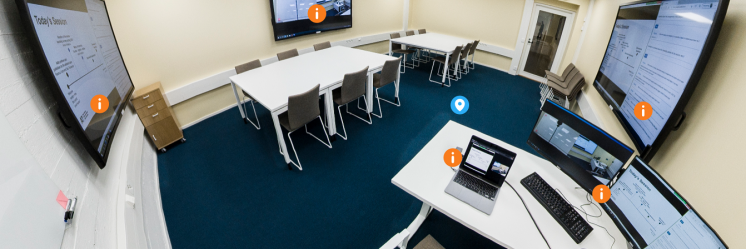Six strategies for more impactful (online) teaching and learning – Part 3/3
What kind of teaching practices can help our students study better? Are we using scientifically proven strategies to enhance learning? This series of three blog posts will introduce you to six evidence-based strategies that support deep learning. Each strategy is complemented by concrete examples that will help you to figure out how to implement these in your teaching!

This series is inspired by and based on a thought-provoking three-hour workshop held by Marcus Lithander, PhD, a cognitive psychologist from KTH Royal Institute of Technology, on the topic in December 2021.
During the workshop, Lithander presented six evidence-based strategies that support deep learning and in this post we will present to you the final two: Concrete examples and Dual coding.
We also recommend reading the parts 1/3 and 2/3 of this series where we introduce you to four other effective strategies.
What works in learning
5. Concrete examples
By definition, concrete example as a concept means “Taking an abstract concept and creating an example based on real-life experiences to solidify the meaning of the concept”. Anyone who has ever learned or taught something knows that concrete examples help and support learning. But why? From the cognitive psychology point of view, this is because by utilizing concrete examples, we connect the episodic memory system (recollecting past happenings, remembering events that took place in spatial and temporal contexts) and the semantic memory system (the capacity for recollecting facts and general knowledge). Using concrete and relevant examples stimulates complex thinking patterns. It can help students to understand abstract ideas and extend information retention.
In practice, this means:
- Using various examples to explain a general concept, for example solving a math problem in multiple ways.
- Enriching the content studied with details and real-life applications (e.g., case studies)
- Encouraging students to create examples themselves
6. Dual coding
Memorizing and memory retrieval are about building and using connections. The more ways a piece of information is connected in your memory, the bigger the chance you will remember it in future.
If a mathematical formula comes to your mind only on seeing its first two symbols, it might happen that you will never use it because real-world items tend not to be tagged with mathematical notations. But if it also comes to your mind when you hear the words ‘tolerance’, ‘fracture’ and ‘welding’, and when you see certain structural designs visually represented, chances are much higher that you will remember which formula you should apply here.
We can build multiple connections and thus help memory retrieval by using dual coding of our material. In other words, use both textual and visual representation of the matter taught. Is there a way to present a given topic as a diagram? A mind map? An infographic? To get full benefit of the visual presentation, make students explain images—or better still, make them create one of their own! (See e.g. Mayer & Anderson 1992.)
Educational sciences have a sticky myth about “learning styles”—that people can be categorized based on how they learn. But as mentioned, this is a myth that is not supported by research evidence. Visual cues will help everyone learn, when combined with textual, oral, auditive and other kinds of presentation media.
In practice, dual coding can be used in the following ways:
- In addition to textual information, formulate your topic into a diagram, mindmap, timeline or chart.
- Try out more advanced visual presentations, such as infographics and comic strips.
- Make the students explain the image or a diagram in their own words.
- Let your students create their own mind maps of the topic at hand.
Co-authored by Akseli Huhtanen, Sara Rönkkönen & Suvi Toivonen
If you are interested in joining Marcus Lithanders workshop in Sping 2022, read more about the upcoming Unite! pedagogical training for teaching staff here: https://www.aalto.fi/en/news/unite-offers-pedagogical-training-for-teaching-staff
References and suggested further readings:
This series of three blog posts is based on and inspired by the workshop “The Science of Learning”, led by PhD Marcus Lithander, Department of Learning and Digital Learning at KTH on 8.12.2021, via UNITE! Network. Also, the following references were utilized when making the posts:
Benjamin, A., Tullis, J. (2010) What makes distributed practice effective?, Cognitive Psychology, Volume 61, Issue 3, 2010,Pages 228––247.
Dunlosky, J., Rawson, K. A., Marsh, E. J., Nathan, M. J., & Willingham, D. T. (2013). Improving Students’ Learning With Effective Learning Techniques: Promising Directions From Cognitive and Educational Psychology. Psychological Science in the Public Interest, 14(1), 4–58.
Gurung, R. A. & Burns, K. (2019). Putting evidence‐based claims to the test: A multi‐site classroom study of retrieval practice and spaced practice. Applied cognitive psychology, 33(5), 732––743
Kang, S. H. K. (2016). Spaced Repetition Promotes Efficient and Effective Learning: Policy Implications for Instruction. Policy Insights from the Behavioral and Brain Sciences, 3(1), 12–19.
Mayer, R. E., & Anderson, R. B. (1992). “The instructive animation: Helping students build connections between words and pictures in multimedia learning.” Journal of Educational Psychology, 4, 444––452.
Rohrer, D. (2012). “Interleaving helps students distinguish among similar concepts.” Educational Psychology Review, 24, 355––367.
Tulving, E. (1972). “Episodic and semantic memory,” in Organization of Memory, eds E. Tulving and W. Donaldson (New York, NY: Academic Press Inc.), 381–403.
Understanding How We Learn. A Visual Guide. Yana Weinstein & Megan Sumeracki. Published by David Fulton/Routledge, August 2018.
https://teachinghow2s.com/
https://www.learningscientists.org/
https://opendigifi.files.wordpress.com/2019/06/61c23-finnishsixstrategiesforeffectivelearningposters.pdf
